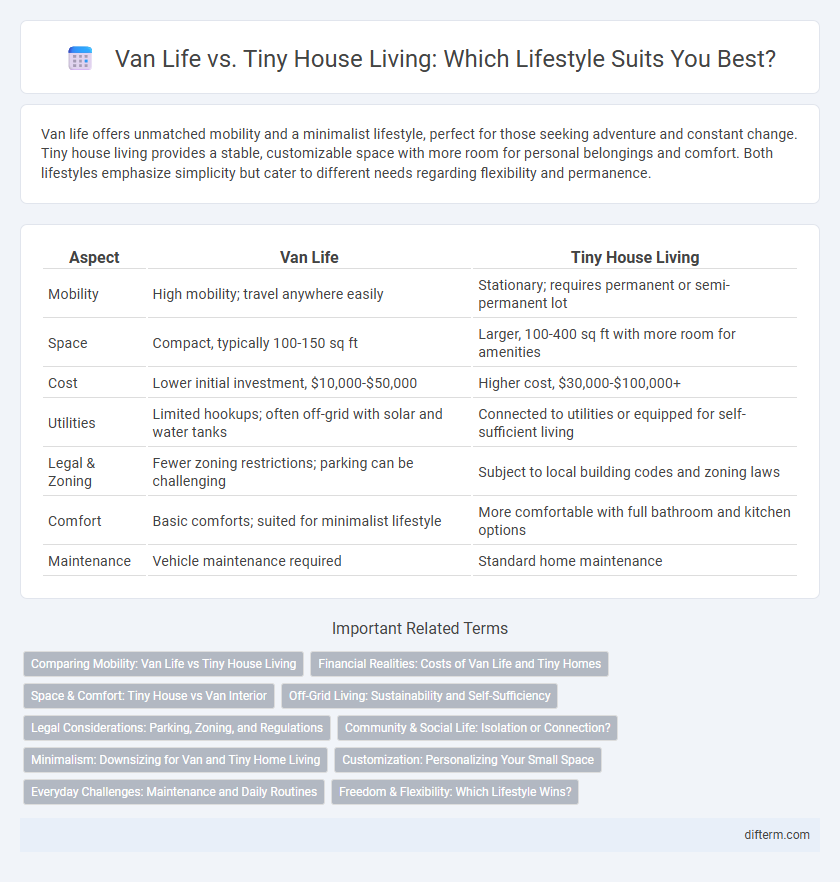Van life offers unmatched mobility and a minimalist lifestyle, perfect for those seeking adventure and constant change. Tiny house living provides a stable, customizable space with more room for personal belongings and comfort. Both lifestyles emphasize simplicity but cater to different needs regarding flexibility and permanence.
Table of Comparison
| Aspect | Van Life | Tiny House Living |
|---|---|---|
| Mobility | High mobility; travel anywhere easily | Stationary; requires permanent or semi-permanent lot |
| Space | Compact, typically 100-150 sq ft | Larger, 100-400 sq ft with more room for amenities |
| Cost | Lower initial investment, $10,000-$50,000 | Higher cost, $30,000-$100,000+ |
| Utilities | Limited hookups; often off-grid with solar and water tanks | Connected to utilities or equipped for self-sufficient living |
| Legal & Zoning | Fewer zoning restrictions; parking can be challenging | Subject to local building codes and zoning laws |
| Comfort | Basic comforts; suited for minimalist lifestyle | More comfortable with full bathroom and kitchen options |
| Maintenance | Vehicle maintenance required | Standard home maintenance |
Comparing Mobility: Van Life vs Tiny House Living
Van life offers unparalleled mobility with the ability to travel and park virtually anywhere, providing spontaneous adventure and flexible living locations. Tiny house living, while offering a more permanent and stable residence, typically requires more effort and expense to relocate, often limiting mobility compared to vans. For those prioritizing travel freedom and frequent moves, van life is the optimal choice, whereas tiny house living suits individuals seeking a balance between mobility and home-like comfort.
Financial Realities: Costs of Van Life and Tiny Homes
Van life typically demands lower upfront costs, averaging $10,000 to $40,000 for a fully customized vehicle, while tiny homes often require $30,000 to $100,000 depending on size and materials. Ongoing expenses for van life include fuel, maintenance, and campsite fees, whereas tiny homes incur property taxes, utilities, and possible mortgage payments. Both lifestyles offer financial flexibility but necessitate careful budgeting to manage unique cost structures effectively.
Space & Comfort: Tiny House vs Van Interior
Tiny houses offer significantly more interior space and built-in amenities, making them ideal for extended stays with comforts like full kitchens and bathrooms. Vans prioritize compactness and mobility, featuring space-efficient designs that maximize storage but often compromise on standing room and luxury. Comfort in tiny houses is enhanced by customizable layouts and better insulation, while vans provide a more minimalist lifestyle suited for those valuing freedom over fixed living quarters.
Off-Grid Living: Sustainability and Self-Sufficiency
Van life and tiny house living both emphasize off-grid living by prioritizing sustainability and self-sufficiency through solar power systems, rainwater harvesting, and composting toilets. Van life offers greater mobility and minimal environmental impact by utilizing compact, energy-efficient designs tailored for travel. Tiny houses provide more stable, customizable spaces with potential for larger renewable energy setups and sustainable gardening, supporting long-term off-grid independence.
Legal Considerations: Parking, Zoning, and Regulations
Van life and tiny house living both face complex legal considerations, especially regarding parking, zoning, and regulations. Vans can be parked temporarily in public areas but are often restricted by local ordinances and require compliance with residential parking rules, while tiny houses, depending on whether they are on wheels or foundations, must adhere to strict zoning laws and building codes that vary widely by municipality. Understanding local regulations and securing permits are crucial to avoid fines and ensure long-term viability in either lifestyle.
Community & Social Life: Isolation or Connection?
Van life offers a nomadic lifestyle that fosters spontaneous connections and a diverse, mobile community but can sometimes lead to feelings of isolation due to constant movement. Tiny house living, often situated in intentional communities or neighborhoods, promotes stable social bonds and a strong sense of belonging. Both lifestyles balance solitude and social interaction differently, shaping unique experiences of community engagement.
Minimalism: Downsizing for Van and Tiny Home Living
Van life and tiny house living both embrace minimalism by drastically downsizing possessions to maximize functionality in limited spaces. Van life demands compact, multi-purpose items and efficient storage solutions to adapt to constant mobility. Tiny house living allows for more customized organization but still requires prioritizing essential belongings to maintain a clutter-free, sustainable lifestyle.
Customization: Personalizing Your Small Space
Van life and tiny house living both offer unique opportunities for customization, allowing individuals to tailor their small spaces to match their lifestyle and preferences. Van conversions often emphasize multifunctional furniture and modular designs to maximize limited square footage, while tiny houses provide more freedom for structural alterations, such as built-in storage and customized floor plans. Personalizing these compact environments enhances daily comfort and efficiency, making them adaptable to various needs and tastes.
Everyday Challenges: Maintenance and Daily Routines
Van life demands frequent maintenance of the vehicle's mechanical systems and limited storage space complicates daily organization. Tiny house living requires ongoing upkeep of compact utilities and managing space efficiency for daily routines. Both lifestyles challenge individuals to balance practical maintenance tasks with adapting to constrained living environments.
Freedom & Flexibility: Which Lifestyle Wins?
Van life offers unparalleled freedom and flexibility by enabling spontaneous travel and easy relocation, while tiny house living provides stability with the option for mobility through portable designs. Van dwellers benefit from minimal setup times and access to diverse environments, whereas tiny house residents enjoy more living space and personalized comfort without permanent ties. The choice depends on prioritizing either constant movement and exploration or a balance between mobility and home-like stability.
van life vs tiny house living Infographic

 difterm.com
difterm.com